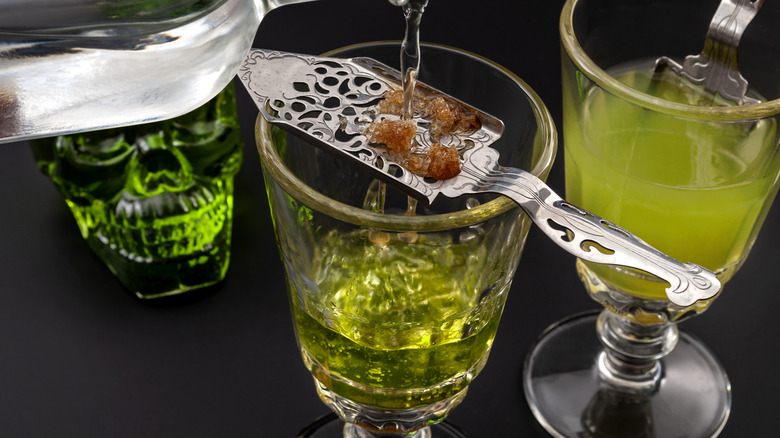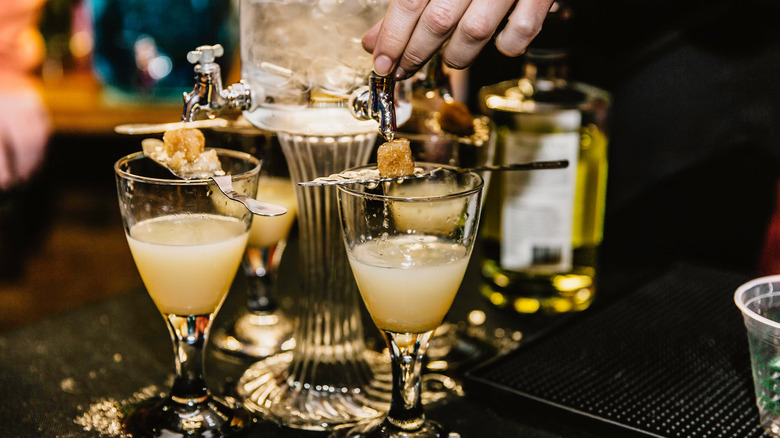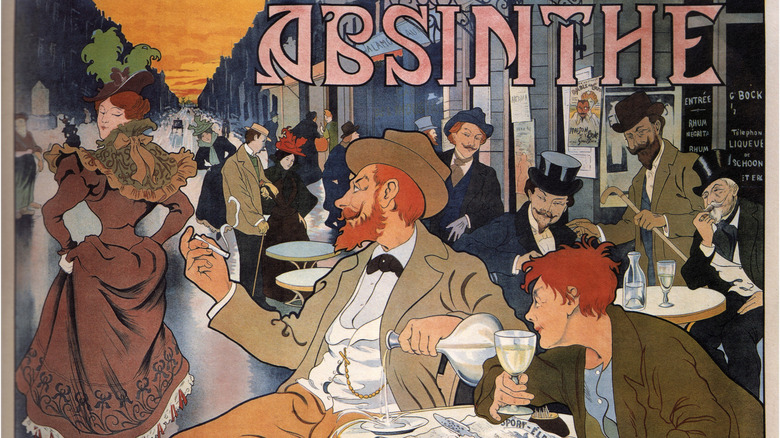The Bizarre Science Of Why Absinthe Gets Cloudy When Mixed With Water
One of the most mysterious spirits in the liquor industry is absinthe. It is an elixir shrouded in lore, rumored to cause hallucinations that would muse romantic artists and writers of the industrial era just as well as incite madness in those who overindulged. But before the sensationalized fear of the green fairy gripped Europe and fueled the temperance movement in America, absinthe was (like many iconic herbaceous spirits) developed as a tonic for medicinal use (via Science History). In the ancient origins of absinthe, Greeks would use the concoction of wormwood-infused wine or spirits to treat gastrointestinal ailments and aid childbirth. In fact, elixirs that featured wormwood as the active ingredient were used medicinally up until the late 1800s when absinthe became associated with the moral decay and degeneration of French and Swiss society. At a time when nationalism was sweeping through Europe and invigorating the industrialization of society, absinthe was demonized for its popularity among freethinkers and those who ascribed to a bohemian lifestyle.
In addition to its "idea-changing liquid alchemy" properties (a quote attributed to Ernest Hemingway has been quoted via Science History), absinthe also undergoes an observable chemical phenomenon that only adds to the mystery of the elixir. When mixed with water, absinthe reacts in what's called the louche or ouzo effect, causing the once-clear emerald solution to turn milky and opaque (according to Difford's Guide).
The science
The simplified explanation for absinthe louche is due to the relationship of ethanol, water, and hydrophobic oils (particularly anethole, which is found in fennel and anise seed) that flavor the spirit (via Glacier Distilling). Ethanol is a molecular social butterfly, it can bond with just about anything including water and oil at the same time. When a liquor is in homeostasis (the water, oils and ethanol are at equilibrium) it appears clear and crystalline. However, as more water is added to the solution, the balance is thrown off. The oils that were previously bonded in the ethanol separate from the water, creating a haze, like a shaken bottle of oil and water. However, unlike shaken oil and water, the opaque spirit doesn't separate as it settles. Instead, the particles of separated oils stay suspended in the solution through a process called spontaneous emulsification.
Though it occurs in most fennel and anise-flavored spirits like ouzo and sambuca, this phenomenon is particularly intense in absinthe because of the intense color contrast of the bright green absinthe turning to milky solution with an ominous green hue. On a molecular level, what we observe happening during this transformation is a spontaneous reorganization of molecular bonds between ethanol, fusel oils, and water called nanoemulsion. This nanoemulsification causes dissolved anise oils to form microscopic droplets, scattering light and causing the drink to turn cloudy (via Science Direct). This is why absinthe will continue to stay hazy for months after its been mixed.
The future uses
The fascinating part of the bizarre science behind the ouzo effect is the potential use of nano-emulsifications in emerging technologies and pharmaceuticals. According to Science Direct, "nanoemulsion techniques can be ideal for the fabrication of nanobiomaterials, because this method can produce spherical nanoparticles with small sized droplets," meaning as science comes to better understand the ouzo effect, the closer we are to developing nanobiotechnology that can revolutionize the medical industry. Similarly, research on the ouzo effect and nanoemulsions allows for pharmaceutical developers to learn new ways of preserving and administering treatments and medicines (IOP Science).
Ironically, absinthe originated as a wormwood tonic used to treat a variety of illnesses and afflictions. As time went on, absinthe became branded as a civil agitant and it was assumed to be the cause of its own particularly violent form of alcohol-induced madness and social dysfunction. Now that we've come to develop better standards and practices for the liquor production, the hysteria around absinthe has diminished to just murmurs and rumors about the green fairy's existence and alleged effect on the mind. However, as absinthe witnesses a revival among the craft aromatic spirits industry, modern science is drawing inspiration from the diaphanous liquor's transformative properties to develop medicinal treatments.


